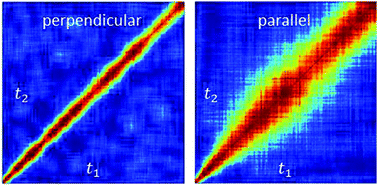Anisotropic and heterogeneous dynamics in stretched elastomer nanocomposites
Abstract
We use X-ray photon correlation spectroscopy (XPCS) to investigate the dynamics of a stretched elastomer by means of probe particles. The particles dispersed in the elastomer were carbon black or silica aggregates classically used for elastomer reinforcement but their volume fraction is very low (ϕ < 10−2). We show that their dynamics is slower in the direction of the tensile strain than in the perpendicular one. For hydroxylated silica which is poorly wetted by the elastomer, there is no anisotropy. Two-time correlation functions confirm anisotropic dynamics and suggest dynamical heterogeneity already expected from the q−1 behavior of the relaxation times. The height χ* of the peak of the dynamical susceptibility, determined by the normalized variance of the instantaneous correlation function, is larger in the direction parallel to the strain than in the perpendicular one. It also appears that its q dependence changes with the morphology of the probe particle. Therefore, the heterogeneous dynamic probed by the particles is not related only to that of the strained elastomer matrix. In fact, it results from modification of the dynamics of the polymer chains near the surface of the particles and within the aggregate porosity (bound polymer). It is concluded that XPCS is a powerful method for investigating the dynamics, at a given strain, of the bound polymer–particle units which are responsible, at large volume fractions, for the reinforcement.



 Please wait while we load your content...
Please wait while we load your content...